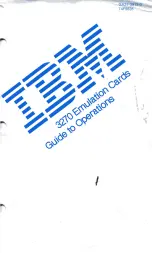
Intel® RAID Controller SRCSAS18E User’s Guide
12
Note: System throughput problems can occur if using SAS cables that do not come with the
RAID controller and that are not the correct type. To minimize the potential for problems:
- Use cables no longer than ten meters for SAS and one meter for SATA. It is better to use
the shortest possible cables. The cable length should be reduced by about one foot (.33
meters) if using a backplane.
- You may connect one device per SATA/SAS cable either as a device or as an expander.
- Route SAS cables carefully
- Use only “straight” SAS cables, not “cross-over” SAS cables.
7. Power On Server
Replace the chassis cover and reconnect the AC power cord(s). Power up the SAS and
SATA devices before or at the same time as the server. If the computer is powered up
before a SAS or SATA device, the device might not be recognized.
During the boot, a BIOS message appears. The firmware takes several seconds to
initialize.
The configuration utility prompt times out after several seconds. The second portion of the
BIOS message displays the RAID Controller SRCSAS18E number, firmware version, and
cache SDRAM size. The numbering of the controllers follows the PCI slot scanning order
used by the host mainboard.
If you want to run the BIOS Console 2 utility, press the appropriate keys when this
message appears:
Press <CTRL><G> to run BIOS Console 2
SAS Device Cables
This section describes the cables used on the SAS controller and provides step-by-step
instructions for connecting SAS and SATA hard disk drives to the SAS RAID controller.
The SAS and SATA protocols use a thin, 7-wire connector.
Note: Use only “straight” SAS cables, not “cross-over” SAS cables.
Figure 3 displays the SAS cable used to connect the internal connectors on a SAS RAID
controller to SAS drives.













































